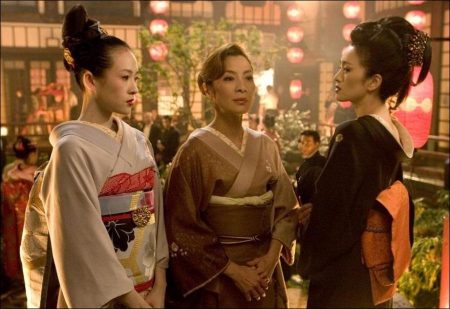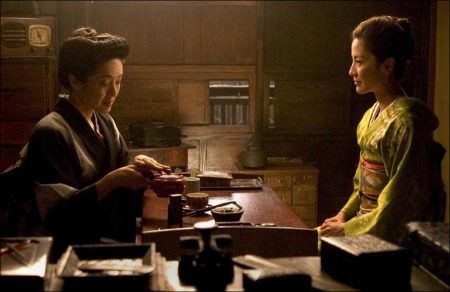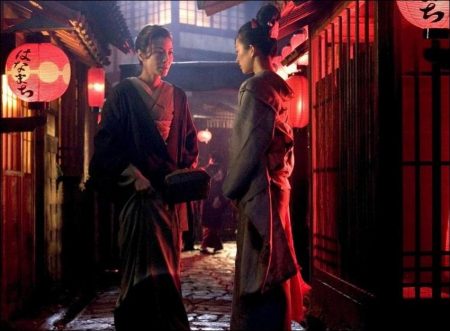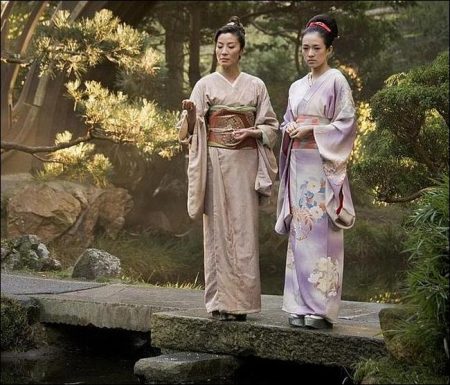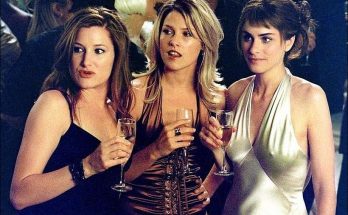Tagline: “My world is as forbidden as it is fragile; without its mysteries, it cannot survive.”
In 1929 an impoverished nine-year-old named Chiyo from a fishing village is sold to a geisha house in Kyoto’s Gion district and subjected to cruel treatment from the owners and the head geisha Hatsumomo. Her stunning beauty attracts the vindictive jealousy of Hatsumomo, until she is rescued by and taken under the wing of Hatsumomo’s bitter rival, Mameha. Under Mameha’s mentorship, Chiyo becomes the geisha named Sayuri, trained in all the artistic and social skills a geisha must master in order to survive in her society. As a renowned geisha she enters a society of wealth, privilege, and political intrigue. As World War II looms Japan and the geisha’s world are forever changed by the onslaught of history.
In 1997, novelist Arthur Golden offered readers an intoxicating and riveting story of a hidden world in his acclaimed novel, Memoirs of a Geisha. The sweeping romantic epic spent two years on The New York Times best-seller list, sold more than four million copies in English, and has been translated into 32 languages.
Now, Oscar-nominated director Rob Marshall (Chicago) and producers Lucy Fisher, & Douglas Wick and Steven Spielberg, along with an acclaimed international cast and an award-winning behind-the-camera team have brought this mesmerizing fable to the screen.
Butterflies of the Night
Set in a mysterious and exotic world which still casts a potent spell today, the story begins in the years before World War II, when a Japanese child is torn from her penniless family to work as a servant in a geisha house. Despite a treacherous rival who nearly breaks her spirit, the girl blossoms into the legendary geisha Sayuri.
Beautiful and accomplished, Sayuri captivates the most powerful men of her day, but is haunted by her secret love for the one man beyond her reach. Geisha have long been figures of fascination in Japan and throughout the world.
For centuries, they have emerged from their homes at dusk like butterflies from a cocoon for a night’s round of teahouse engagements. Social evenings have always been an important part of business in Japan, and the presence of geisha reflects well on the host who can afford such glamorous companions.
Neither wife nor prostitute, a geisha is an artist who earns her living entertaining powerful men. The word gei (pronounced gay) means “art” in Japanese. A geisha is a trained dancer, singer and musician, as well as a witty conversationalist. She laughs at her client’s jokes — and never tells his secrets. She creates drama with a simple flick of her fan.
Years of hard work and self-discipline have transformed her into this refined creature, but underneath her binding layers of kimono and neutral mask of make-up is a flesh and blood woman with her own history, disappointments and dreams. The secrets she guards most closely belong to her own heart.
The geisha districts described so vividly in Arthur Golden’s novel still exist today, and authentic geisha continue to entertain in elegant old teahouses. They dress, groom themselves and perform as geisha have for centuries. Women who become geisha today are often drawn to the profession through an interest in the traditional arts and may remain in it only a few years. Once their country’s most fashionable women, top geisha were the supermodels of their day until “modern” came to be defined as Western in Japan.
Memoirs of a Geisha begins in 1929, near the end of the geishas’ golden era. Told as a fable from a disappearing world, the film is set in a fictional hanamachi or geisha district. As Sayuri (Ziyi Zhang) enters this hidden world, she is taught that a geisha is not free to love, or to pursue her own destiny. Her mentor, the legendary geisha Mameha (Michelle Yeoh), understands the limits of an intimate relationship with a special patron or danna, and teaches Sayuri to keep her feelings tightly reined. Unlike Sayuri’s defiant rival Hatsumomo (Gong Li), Mameha knows that a proper geisha cannot afford to indulge her passion for any man.
Yet Sayuri cannot forget a moment of unexpected kindness she experienced at an early age. The memory of that moment shimmers like a mirage, and sustains her through years of suffering. Looking back at her life, she remembers “a little girl with more courage than she knew,” and reflects, “These are not the memoirs of an Empress, nor of a Queen. These are memoirs of another kind.”
The Perfect Fit
Ziyi Zhang experienced a not uncommon reaction after reading Arthur Golden’s novel Memoirs of a Geisha. “I couldn’t believe that a man wrote this book about the life of a woman,” said the actress. “And I couldn’t believe it was an American man writing with such detail about a little-known Japanese sub-culture.”
Director Rob Marshall savored the exotic world in which the story unfolds, but said he was just as taken by the universality of the young orphan Chiyo’s plight, and her eventual triumph after an accidental meeting changes the course of her life. “This story lives in a very specific world, and yet the underlying theme of the triumph of the human spirit against all odds connects to any culture,” said Marshall. “The fact that this one child, after being taken from her home and sold into slavery, can survive and ultimately find love is deeply moving to me. Especially when that love is forbidden to her.”
Wick, the Academy Award-winning producer of Gladiator, acquired the film rights soon after the novel was published, and gave a copy to Columbia Pictures chairman Amy Pascal (then head of production at the studio). Fisher, who was then vice chairman of the Columbia Tristar Motion Picture Group, said, “It was so captivating, I just could not put the book down. We all believed it had such vivid movie potential in terms of its roles and its visual life.”
Among the book’s great strengths were Sayuri’s keen observations as she encounters a world that she (along with most readers) had never even imagined. “We knew that capturing the essence of her interior monologue would be a challenge,” said Fisher, “but it was also an opportunity. We were recounting the reminiscences of a woman whose life took an amazing turn when she was just nine years old. Much of what she shares is first seen through the eyes of a child, which gave us freedom to tell her story as more of a fable.”
After working as an executive on many films with Steven Spielberg, Fisher anticipated that he would also fall under the novel’s spell. He signed on as director, and preliminary pre-production work began.
“Culturally, it was one of the most fascinating stories I had ever encountered,” said Spielberg. “I was very moved by the love story, by the rivalry between Sayuri and Hatsumomo, and by the test of friendship between the Chairman and Nobu. I thought audiences all over the world would be fascinated because it’s not just culturally significant as legend or history from Japan. It’s relevant to people in every country. It was certainly relevant to me.”
However, after several near-starts, it became clear that Spielberg’s calendar could not accommodate the demanding project, so he stepped aside, remaining on board as a producer. With the director’s chair open and dozens of candidates vying for the project, Wick and Fisher began their search for the perfect fit.
An Impression of Time and Place
As soon as Fisher and Wick saw an advance screening of Chicago, they knew they had found their director. A boldly modern presentation of a tale from an earlier era, Rob Marshall’s feature film debut was a critical and commercial sensation recognized with a string of major awards including the Oscar for Best Picture and five additional Academy Awards. Marshall himself received a Best Director Oscar nomination and the Director’s Guild Award.
When Fisher and Wick first sat down with Marshall and heard his vision of the movie, “it was exhilarating,” said Wick. “Transforming a beloved work of art from one medium to another is a huge challenge, but Rob had absolute clarity about his path through the novel. The look and feel of the film would reflect that it is a memory piece told years later – an impression of a time and place experienced at a young age rather than a literal recreation. We could almost see the movie as he talked about it. Rob would not be afraid to bring his own aesthetic vision to the material, just as he demonstrated with his innovative approach to Chicago. He wanted the audience to experience the wonder Sayuri felt as she discovered the geisha world.”
Author Arthur Golden was similarly enthused when he heard that Marshall would be directing the film. “I was madly in love with Chicago,” he said. “It was a better version of the play that I had loved. So when I heard that Rob was interested in directing the movie of my novel, I was thrilled!”
The first thing Marshall did to prepare for the project was reread the book. “I needed to take the journey from the beginning and see what hit me,” he said. The director was well aware that he was not preparing to make a geisha documentary. “I knew that the drama of these characters combined with the allure and exoticism of their world would allow us to achieve something unique and compelling,” he said.
Soon after, Robin Swicord (Little Women, Matilda) came on board to write the screenplay. Marshall and the producers stayed in regular contact with Golden as the script took shape. “Rob said to me very early on, ‘I want to make a movie you love,’” Golden recalled. “We spent many hours talking about how the story is put together and ways to make things better for the film. He sent me every draft of the screenplay.”
Marshall then gathered the key members of his team for a trip to Japan. “I had decided to tell Sayuri’s story as an impression of a time and place, but needed to thoroughly understand the reality first,” the director explained. “We all agreed that total immersion in Sayuri’s world was the only way to begin, so we traveled to Kyoto together to experience everything we could.”
The group of 10 visited museums and shrines, toured a kimono factory, attended a sumo match, rode in rickshaws, scouted the coast of the Sea of Japan, attended spring festival dances and watched an apprentice geisha (maiko) apply her makeup and dress. Marshall and John DeLuca, the film’s co-producer and choreographer, were invited backstage to witness the legendary actor-dancer Tamasaburo Bando prepare for a Kabuki performance.
Absorbing the atmosphere of Gion and other hanamachi (geisha districts) was essential to their mission. “Dion (Beebe, the film’s director of photography) and Rob and I would let ourselves get lost and just take photographs,” said Oscar-winning production designer John Myhre. “When it came time to construct our buildings, we’d go through our pictures and say ‘that roof would look really nice with this type of window, which would look great with this type of door.’”
Potential locations for filming were identified, but Marshall, Myhre, Beebe and executive producer Patricia Whitcher realized they could not shoot the entire movie in Japan. “When we analyzed the amount of work we had to do in the streets,” Whitcher explained, “there was just no way we could disrupt an active community for that long to recreate what we needed to tell this story.”
Also, Japan’s hanamachi, or geisha districts, had changed greatly since the period during which the film occurs. “Even in the beautiful ancient cities, we could not find an area of businesses that was untouched by modern elements,” Marshall said. But the group came home inspired by their shared experience and by the collective set of references that they would draw from over the coming months.
Memoirs of a Geisha (2005)
Directed by: Rob Marshall
Starring: Zhang Ziyi, Ken Watanabe, Michelle Yeoh, Youki Kudoh, Koji Yakusho, Karl Yune, Elizabeth Sung, Li Gong, Tsai Chin, Zoe Weizenbaum, Eugenia Yuan, Miyako Tachibana
Screenplay by: Ron Bass, Akiva Goldsman
Production Design by: John Myhre
Cinematography by: Dion Beebe
Film Editing by: Pietro Scalia
Costume Design by: Colleen Atwood
Set Decoration by: Gretchen Rau
Art Direction by: Patrick M. Sullivan Jr.
Music by: John Williams
MPAA Rating: PG-13 for mature subject matter and sexual content.
Distributed by: DreamWorks Pictures
Release Date: December 23, 2005
Visits: 149
